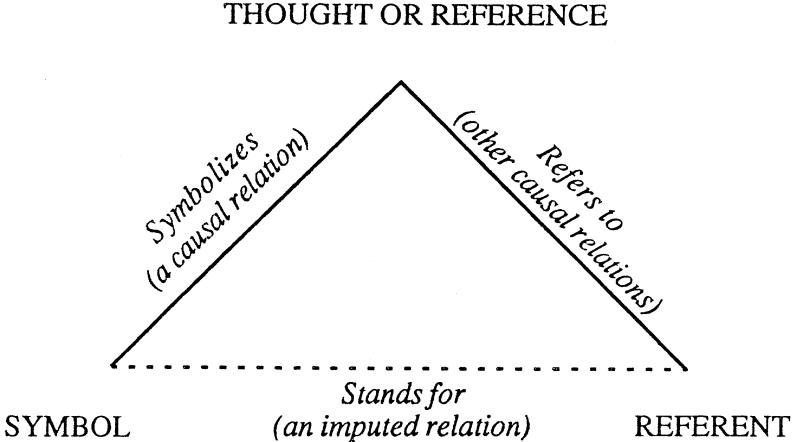
- •Word semantics
- •1. The Concept and Definition of Meaning
- •The Word Defined
- •1.2. The Word in Different Languages
- •1.3. Characteristics of words
- •Word meaning
- •2.1. The word as a linguistic sign
- •2.2. Denotation and reference
- •2.3. Denotation vs. Connotation
- •2.4. Inherent and adherent connotation
- •2.5. Pragmatic meaning
- •3. Polysemy
- •3. 1. The notion of polysemy
- •3.2. Ways to have multiple senses of a word
- •3.3 Results of semantic change
- •3.4. Polysemy in dictionaries
- •3.5. Analysing meaning
- •3.5.1. Componential analysis
- •2.2. Prototype theory
- •4. Homonymy
- •4.1. Homonyms defined
- •4.3. Homonym clashes
- •Polysemy vs. Homonymy
Word meaning
2.1. The word as a linguistic sign
It would not make sense, while engaging in a discussion of the word, not to look at it from the perspective of semiotics. Semiotics, as a study of signs, sees the word as a linguistic sign. According to Saussure, the linguistic sign is a two-faceted mental construct. It is seen as an organic unity between a concept and a sound form. The two sides of the sign are:
the signifier (the shape" of a word, its phonic component, i.e. the sequence of letters or phonemes) – «означальне» (словесно реалізована одиниця)
the signified (the ideational component, the concept or object that appears in our minds when we hear or read about the signifier) – «означуване» (одиниця смислу).
(The signified is not to be confused with the referent. The former is a mental concept, the latter the actual object in the world)
Semiotic triangle
SENSE (CONCEPT; CONTENT)

WORD (EXPRESSION; REFERENT
SIGNIFIER) (OBJECT; REFERENCE)
A referent is the concrete object or concept that is designated by a word or expression. A referent is an object, action, state, relationship, or attribute in the REFERENTIAL REALM. Writers have variously said that an expression stands for, designates, refers to, or denotes its reference.

Ogden and Richards’ (1923) semiotic triangle
Sowa (2000) writes about Ogden & Richards' (1923) triangle of meaning: "The triangle in Figure 1 has a long history. Aristotle distinguished objects, the words that refer to them, and the corresponding experiences in the psychê. Frege and Peirce adopted that three-way distinction from Aristotle and used it as the semantic foundation for their systems of logic. Frege's terms for the three vertices of the triangle were Zeichen (sign) for the symbol, Sinn (sense) for the concept, and Bedeutung (reference) for the object." With many signifiers that stand for abstract notions, notions that constitute really high levels of abstraction, which is to say, do not really exist other than in our minds, a concept and a referent are always somewhat symbolic. We don't have access to them outside of representation. The relationship between a symbol and a concept is a complex one, as a mental representation that the sign evokes is mediated by a lot of factors: our past experiences, pre-conceived notions and cultural constructs. This means that one and the same linguistic sign is sure to evoke different mental representations (concepts) for different people. If not given explicit context, on hearing the word tank different people will think of different objects (tanks as heavy military machinery, as a water tank, fish tank, fuel tank etc.) Even if the context is provided, as in I’ve never seen a tank up close as part of a discussion about military vehicles; the word will conjure up a different mental picture for those who participate in it. Some will think of the old-type tanks used in WWII, others will imagine the new sophisticated, state-of-the-art vehicles, still others will think of the ones that the US has used in the Iraqi war. Our access to concepts, therefore, is mediated in many different ways and they (concepts) may be communicable only through other representations, which are signs themselves.
